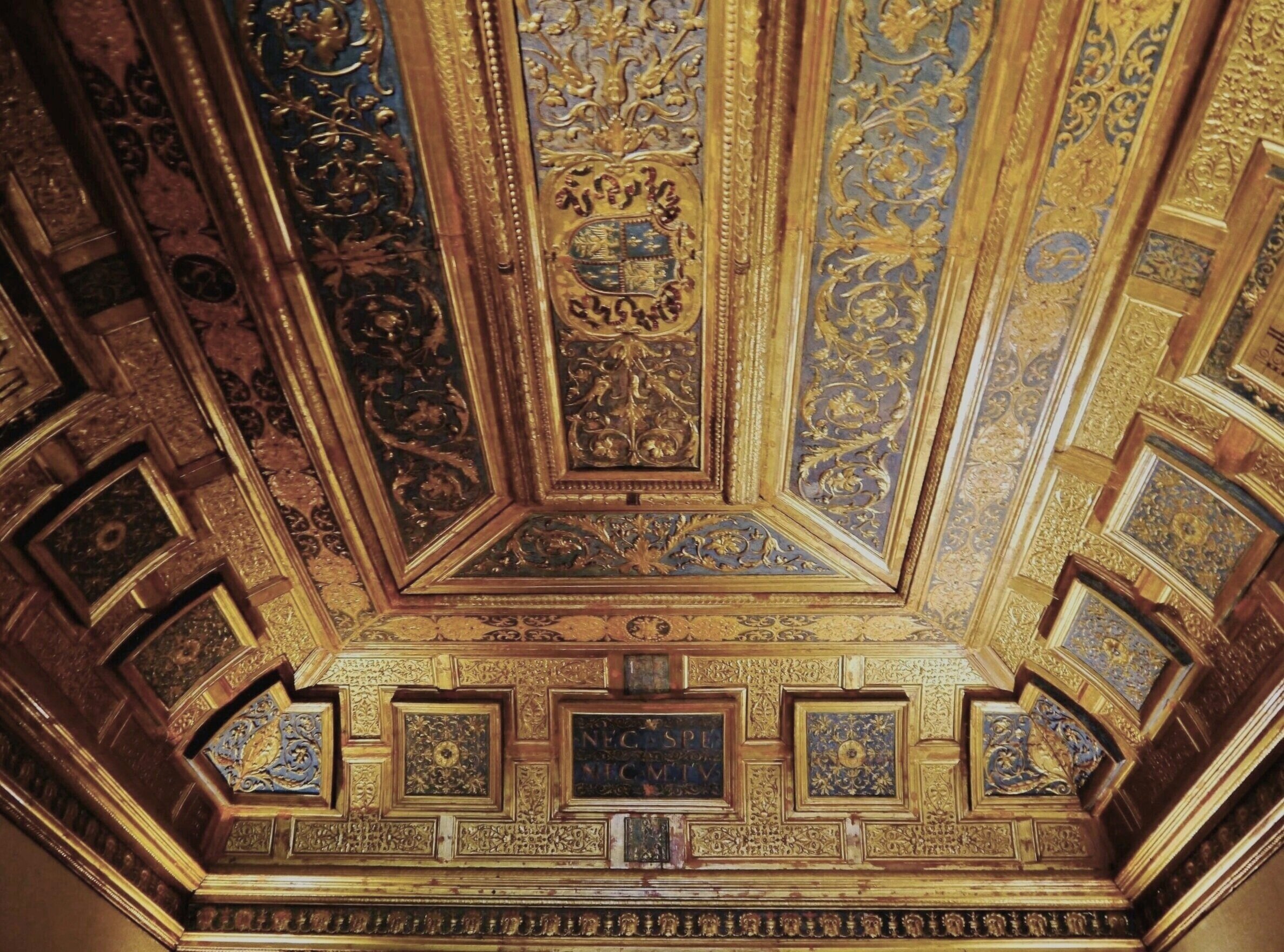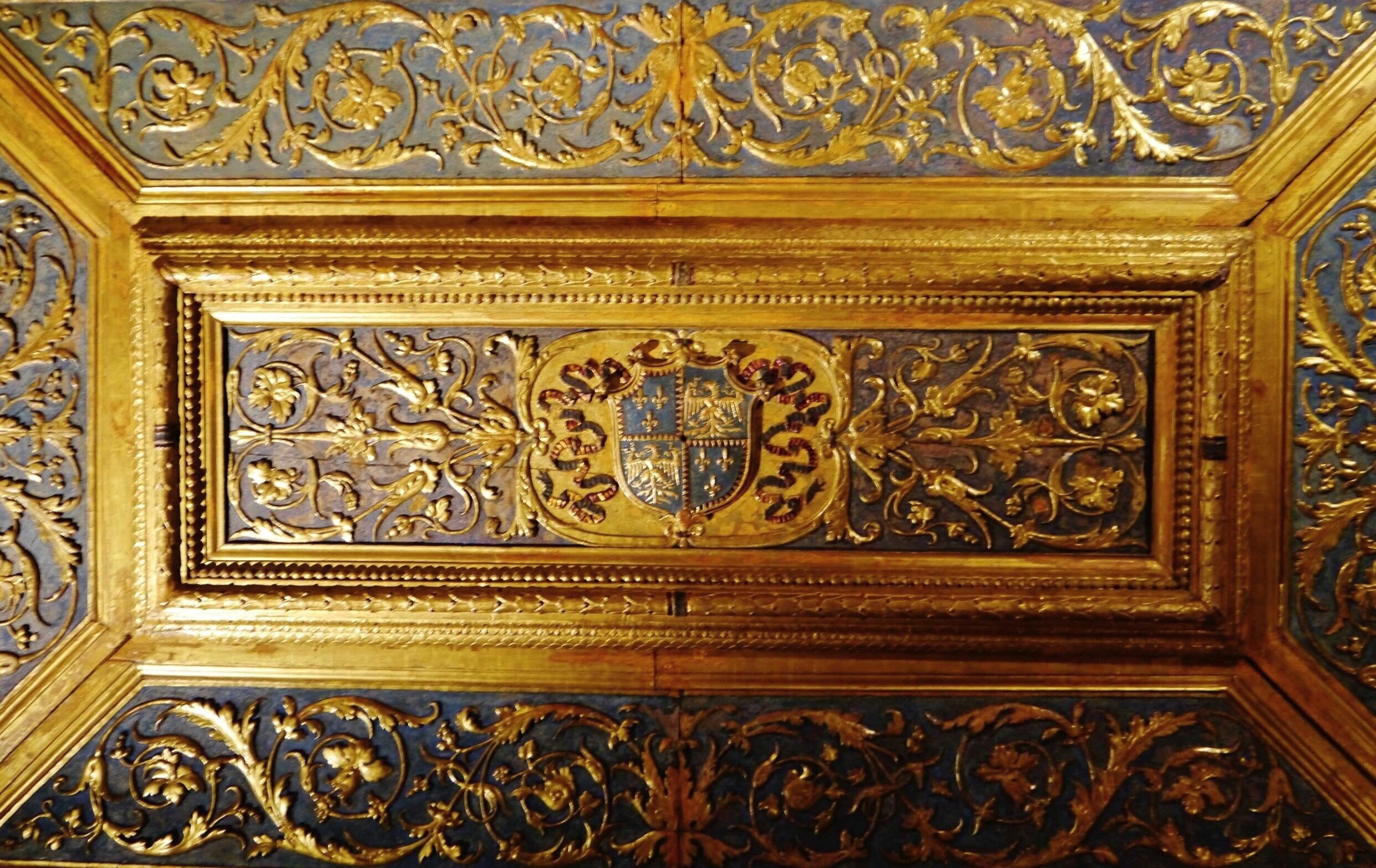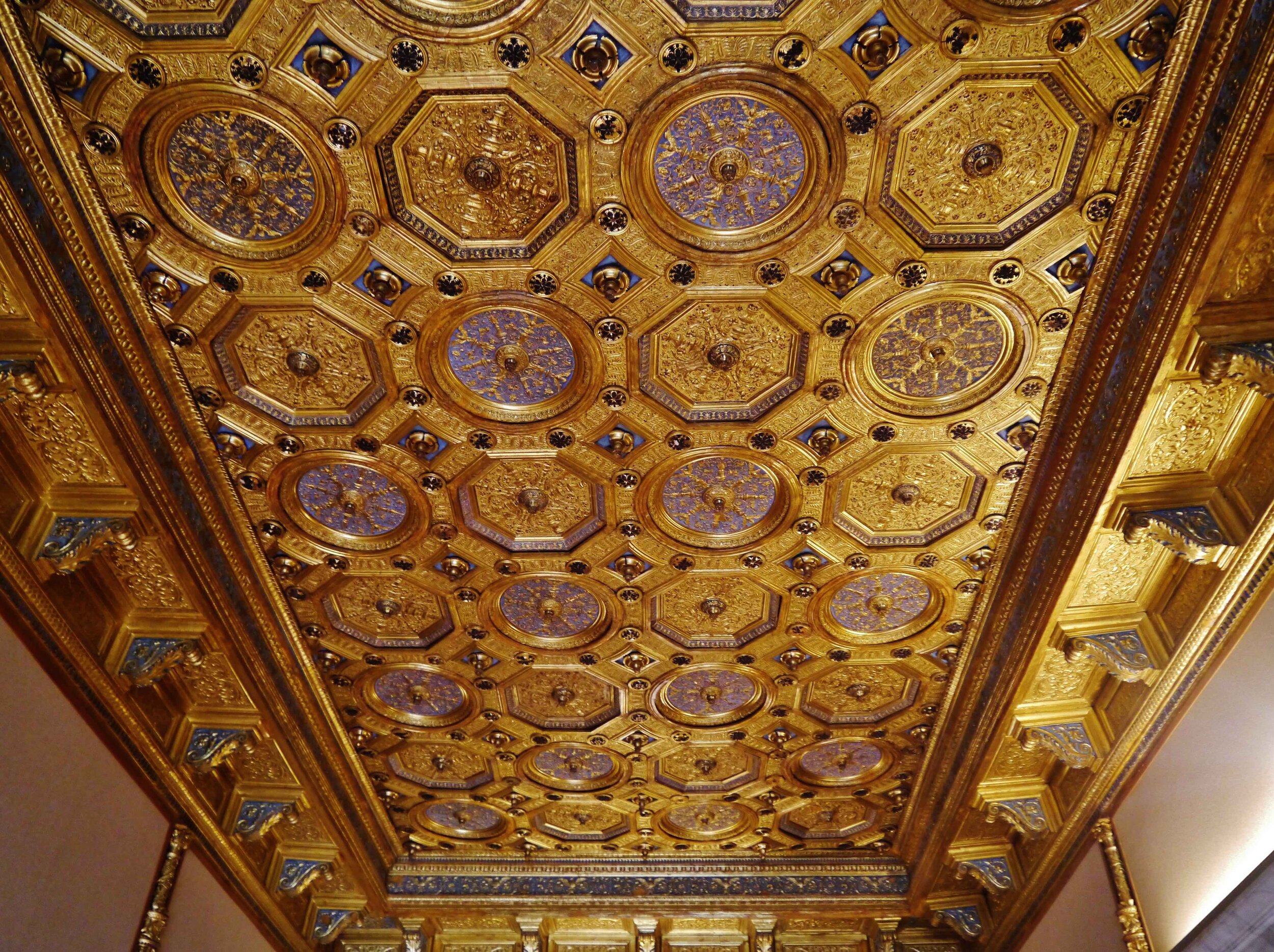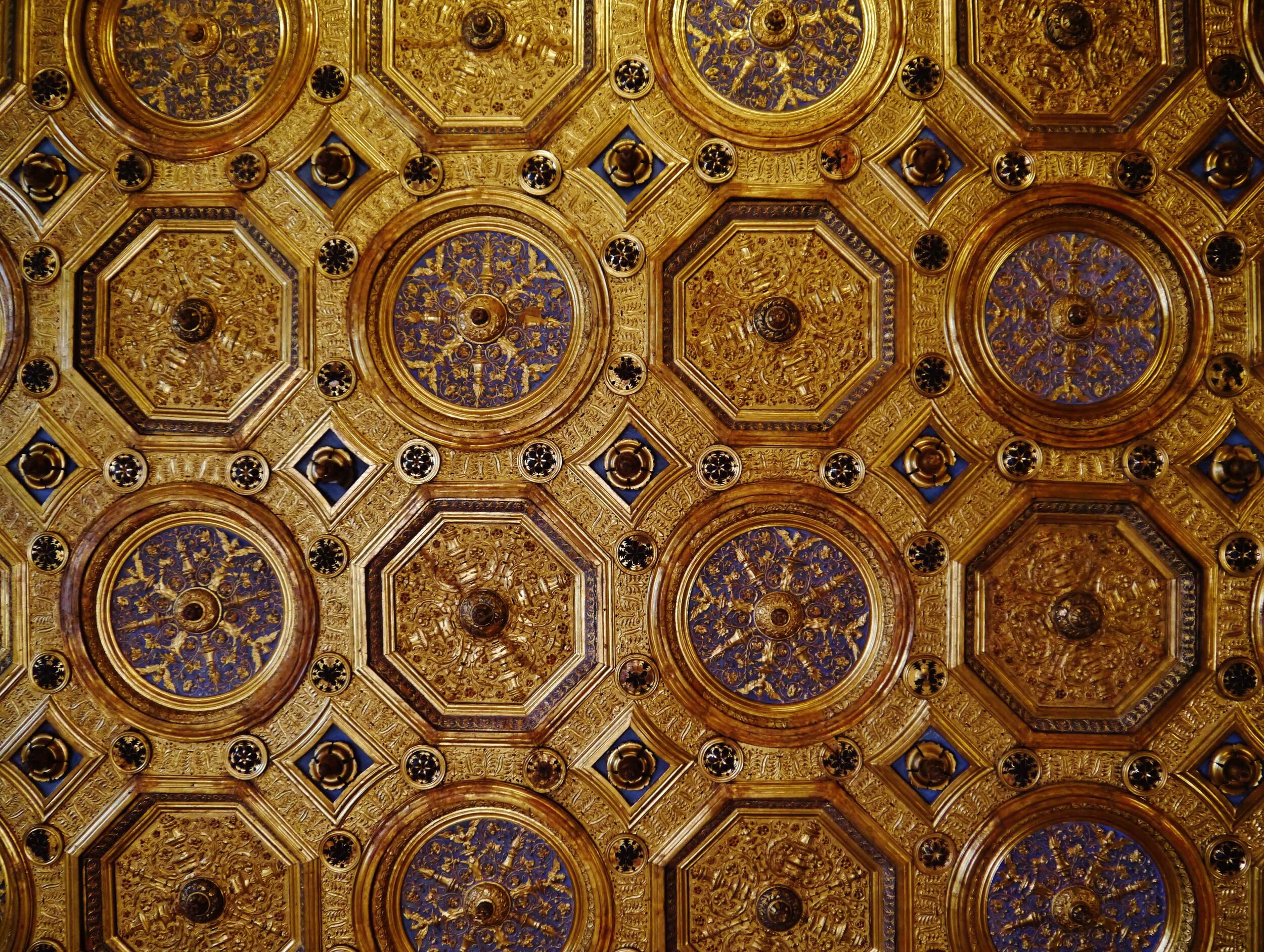Sleeves, colour and berettino
Fig. 1 Isabella’s sleeve, detail of Titian, Isabella d’Este.
In her 1534-36 portrait by Titian, Isabella d’Este wears a fashionable black velvet gown with contrasting silk sleeves in a deep bluish shade of berettino (grey) (Fig. 1). Typically, a gown was assembled by tying, lacing or pinning together a pair of sleeves, a bodice, an over-gown and perhaps shoulder rolls and an under-skirt. These garments could be of matching or contrasting colours and fabrics, with sleeves often providing a focal point, as Isabella’s do here. Consequently, outfits could be varied or updated simply by swapping in different sleeves. Additionally, the sleeves themselves could be refurbished or reworked, a practice that evidently took place in the court circles to which Isabella belonged. While it was not unusual for women of the artisanal classes to own a pair of silk sleeves, sometimes embroidered with colourful silk thread, only members of the wealthy elite could afford sleeves fashioned from gold brocade, decorated with jewels, or, as we see here, elaborately embroidered with gold and silver thread [1].
Fig. 2 Knot-work designs from the inventory of Isabella’s rooms. Il codice Stivini: inventario della collezione di Isabella d'Este nello studiolo nella grotta di corte vecchia in palazzo ducale di Mantova [Facsimile edition]. Edited by Roberta Iotti and Daniela Ferrari. Modena: Il Bulino,1995. Image: Facsimilefinder.
In dress, as in many other spheres, Isabella was a fashion leader, and her innovative sense of style was well-known and widely admired in the courts of Europe [2]. While we know that she did not sit for this portrait, leaving items of clothing for a portraitist to reproduce in fine detail was an accepted practice. Given the precision with which Titian has depicted some of the items she wears, they were in all likelihood Isabella’s actual garments. He painted the portrait in the mid-1530s, and despite basing the face on a 1511 portrait by Francesco Francia, the dress was contemporary in style, with black gowns a courtly fashion in this period [3]. The sleeves, moreover, can be closely identified with Isabella herself. The elaborate knot-work design of their embroidery was one of her personal devices, also appearing in the manuscript of a postmortem inventory of her rooms (Fig. 2) [4].
Additionally, berettino was one of her signature shades, a colour she remains closely associated with [5]. She repeatedly combined it with black in her outfits, and sometimes with another of her signature shades, morello (literally, blackberry), a dark brown tending to red, violet, purple or black. Involving herself not only in the styling of her outfits, but also their construction, Isabella sourced fabrics from a range of Italian textile centres, often having them manufactured expressly. In June 1496, for example, she wrote to Giorgio Brognolo in Venice, asking him to have a length of berettino satin made, and specifying that the shade should not be excessively light nor dark. She also obtained berettino silk velvet from Genoa, and had fabrics striped in black and her signature shades made in Venice and Milan [6].
Berettino silks were a novel development in late fifteenth-century Italy. Improvements in dyeing techniques meant that this colour, formerly associated only with the cheapest woollens, became available in a range of fabrics and fibres, including the superior silk fabrics worn by the nobility. The methods for dyeing berettino shades given in fifteenth- and sixteenth-century Venetian handbooks all combine gallo-tannic dyestuffs with iron compounds, most often specifying oak gall, which was also used to dye black and to make ink [7]. Galls formed on species of oak that grew in Syria, Turkey and Istria, although the Istrian galls, with a lower concentration of colourant, were of lesser quality [8]. They were obtained by Italian textile centres via eastern Mediterranean and Adriatic trade routes that by this period were dominated by Venetian shipping. In one handbook, dated to the end of the fifteenth century, a master-dyer explains how to use oak gall to dye silk “beretino scuro” (dark grey), and fabrics of linen and cotton in the lighter shades of “beretine” (grey) or “arzentin beretin” (silver grey) [9]. Extant fabric samples with associated descriptions are rare for this era, however a precious 1628 Milanese collection includes four swatches of berettino silk. One, its colour labelled simply as “beretino”, is a middle shade of grey, while another, labelled “beretino scuro” (dark grey), is a deep grey with a brownish tinge. Of the remaining two, which are both labelled “beretino chiaro” (light grey), one is a lighter version of the middle grey, while the other is a much paler dove-grey shade (Figs. 3-5) [10].
Fig. 3 Berettino. Detail from Archivio di Stato di Milano, Fondo Cimeli, 1/24, car. 3r. 13.
Fig. 4 Berettino scuro. Detail from Archivio di Stato di Milano, Fondo Cimeli 1/24, car. 7r. 4.
Fig. 5 Berettino chiaro. Detail from Archivio di Stato di Milano, Fondo Cimeli 1/24, 1628, car. 2v. 5.
Fig. 6 Nicola da Urbino, Jupiter and Semele, plate (c. 1524). Earthenware (maiolica), 2.9 × 27.1 cm diameter. National Gallery of Victoria, Melbourne. Felton Bequest, 1940. Photo: National Gallery of Victoria, Melbourne.
Although berettino was not one of the seven heraldic colours of renaissance Italy, its bluer shades, including the deep blueish grey of the portrayed sleeves, could nevertheless represent heraldic blue, one of Isabella’s armorial colours. As we have established, in the context of textiles, berettino was a generic term for grey, sometimes qualified as dark, light or even silvery. While it is risky to compare the colours of the Milanese fabric samples and Isabella’s painted sleeves without the actual artefacts to hand, the berettino of the sleeves is a relatively deep shade, and cooler in tone than the fabric samples, tending towards blue rather than brown. A discussion of berettino in a sixteenth-century treatise on silk-raising reveals further shades, such as berettin purpureo or violato (purple or violet grey) and cinerino (ashy), as well as a variegated grey known as berettino inzuccarato (sugared grey) [11]. However, when it comes to maiolica, berettino refers to a pale ash-blue glaze [12]. Interestingly, the surviving pieces of Isabella d’Este’s own maiolica service are glazed in blues and yellows, often incorporating her stemma (coat of arms) and imprese (heraldic devices). The blue glazes range from pale shades to an intense cobalt blue, with the cobalt used for the blue fields of the stemma (Fig. 6) [13].
However, the heraldic colours of gold, silver, red, blue, black, green and purple were not always represented by focal colours, but served rather to partition the colour space, with orange and pink, for example, both considered heraldic red [14]. Isabella’s stemma also appears on the ceiling of her new Grotta, which is decorated in its main colours, gold and blue, but in this case, an azzurro berettino (ash-blue) that is yet another shade of berettino (Figs. 7-10) [15]. Clearly this shade can be read as heraldic blue, and thus so too can the similar blueish grey of the painted sleeves. It is often though that Isabella adopted berettino as a signature colour simply because it flattered her [16]. However, I would argue that the shade that she wears on her sleeve in this portrait also represented her armorial blue.
Tracey Griffiths




Notes
[1] ^ Evelyn Welch, ‘New, Old and Second-Hand Culture: The Case of the Renaissance Sleeve’, in Revaluing Renaissance Art, ed. Gabriele Neher and Rupert Shepherd (Aldershot: Ashgate, 2000), 103-9; Christine Shaw, Isabella d’Este: A Renaissance Princess (London and New York: Routledge, 2019), 117-18. On silk sleeves owned by artisans, see Paula Hohti, ‘Dress, Dissemination and Innovation: Artisan Fashions in Sixteenth- and Early Seventeenth-Century Italy’, in Fashioning the Early Modern: Creativity and Innovation in Europe, 1500-1800, ed. Evelyn Welch (Oxford: Oxford University Press, 2016), 155-57, 160, 162.
[2] ^ Evelyn Welch, Shopping in the Renaissance: Consumer Cultures in Italy, 1400-1600 (New Haven: Yale University Press, 2009), 251; Eugenia Paulicelli, Writing Fashion in Early Modern Italy: From Sprezzatura to Satire (Farnham: Ashgate, 2014), 23-27.
[3] ^ Shaw, Isabella d’Este, 90; on black gowns, see Carole Collier Frick, Dressing Renaissance Florence: Families, Fortunes, and Fine Clothing (Baltimore: Johns Hopkins University Press, 2005), 175.
[4] ^ Shaw, Isabella d’Este, 85; Archivio di Stato di Mantova, Inv. b. 400, Codice Stivini - Inventario delle gioie di Isabella d'Este. On knot designs as a versatile early sixteenth-century fashion, see Paulicelli, Writing Fashion, 27.
[5] ^ Shaw, Isabella d’Este, 118; Jacqueline Herald, Renaissance Dress in Italy 1400-1500 (London: Bell and Hyman, 1981), 210; Collier Frick, Dressing Renaissance Florence, 302.
[6] ^ Shaw, Isabella d’Este, 118; Chiara Buss, ‘Silk Gold Crimson’, in Silk Gold Crimson: Secrets and Technology at the Visconti and Sforza Courts, ed. Chiara Buss (Milano: Silvana, 2009), 57.
[7] ^ “Manuale di tintura,” n.d., manuscript number 4.4.1, Biblioteca Civica di Como; Gioanventura Rosetti, Plictho de larte de tentori che insegna tenger pani telle banbasi et sede si per larthe magiore come per la comune (Vinegia: Agustino Bindoni, 1548). A critical edition of the complete Como manuscript has been published as Giovanni Rebora, ed., Un manuale di tintoria del quattrocento (Milan: Dott. A. Giuffrè Editore, 1970). The Plictho has been published in facsimile, along with an English translation, as Gioanventura Rosetti, Plictho of Gioanventura Rosetti: Instructions in the Art of the Dyers Which Teaches the Dyeing of Woolen Cloths, Linens, Cottons, and Silk by the Great Art as Well as by the Common, trans. Sidney M. Edelstein and Hector C. Borghetty (Cambridge: MIT Press, 1969). For recent experimentation using its instructions to dye black, see Paula Hohti et al., 'Exploring Historical Blacks: The Burgundian Black Collaboratory', Refashioning the Renaissance - Popular Groups and the Material and Cultural Significance of Clothing in Europe 1550-1650 [Blog], 21 February 2019, https://refashioningrenaissance.eu/exploring-historical-blacks-the-burgundian-black-collaboratory/.
[8] ^ Paolo Bensi, ‘New Dyestuffs, New Shades: Silk Dyeing in Italy Between the Late Sixteenth Century and the Early Eighteenth Century’, in Silk Gold Incarnadine: Luxury and Devotion in Lombardy Under Spanish Rule, ed. Chiara Buss (Cesano Maderno (MB): ISAL, 2012), 34.
[9] ^ Rebora, ed., Un manuale di tintoria, 62, 82.
[10] ^ The four fabric samples are: Archivio di Stato di Milano, Fondo Cimeli, car. 2v. 5, car.3r. 13, car.7r. 4, 10r. 3. For a facsimile of the sample book, see Chiara Buss, Seta. Il dizionario delle mezzetinte 1628-1938. Da Avinato a Zizzolino (Milano: Silvana, 2013), 11-29. On the berettino samples, including enlarged reproductions of three of them, see Chiara Buss, ‘Half-Tints in Italy in 1628: An Unusual Book of Samples from the Milan State Archives’, in Inventories of Textiles – Textiles in Inventories: Studies on Late Medieval and Early Modern Material Culture, ed. Thomas Ertl and Barbara Karl (Göttingen: Vandenhoeck & Ruprecht, 2017), 183-87.
[11] ^ Giovan Andrea Corsuccio da Sascorbaro, Il vermicello dalla seta (Rimini: Gio. Simbeni, 1581), 105; Luca Molà, The Silk Industry of Renaissance Venice (Baltimore: Johns Hopkins University Press, 2000), 133.
[12] ^ Paul Hills, Venetian Colour: Marble, Mosaic, Painting and Glass 1250-1550 (New Haven: Yale University Press, 1999), 223-24.
[13] ^ ‘IDEA Ceramics’, Art/e, IDEA: Isabella d’Este Archive, accessed 7 October 2019, http://ideaart.web.unc.edu/idea-ceramics/
[14] ^ Mariarosa Palvarini Gobio Casali, ‘Ceramiche a Mantova al tempo dei Gonzaga; Ceramics in Mantua at the Time of the Gonzaga’, in Una ‘credenza’ istoriata per Isabella d’Este: Il servizio di Nicola d’Urbino interpretato da Ester Mantovani; A Narrative-Painted ‘Credenza’ for Isabella d’Este: Nicola d’Urbino’s Service as Interpreted by Ester Mantovani, ed. Mariarosa Palvarini Gobio Casali and Daniela Ferrari (Mantova: Universitas Studiorum, 2014), 32-34.
[15] ^ Michel Pastoureau, Black: The History of a Color, trans. Jody Gladding (Princeton: Princeton University Press, 2008), 71.
[16] ^ Rosita Levi Pisetzky, Il costume e la moda nella cocietà italiana (Torino: G. Einaudi, 1978), 66.







Patricia Lurati